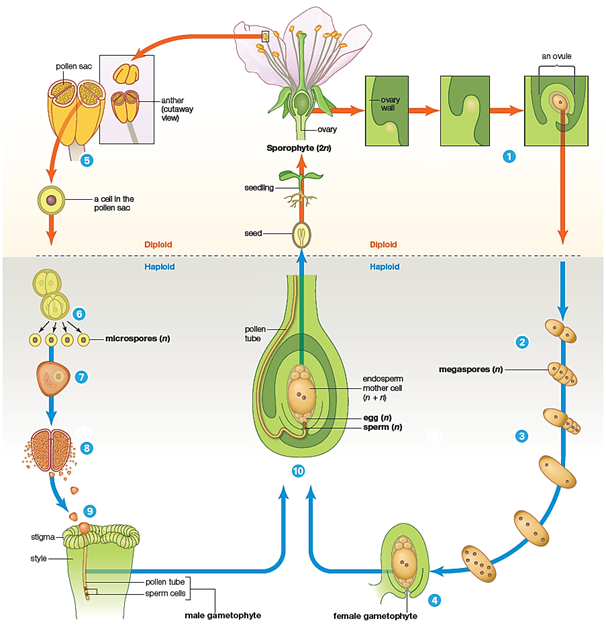Matching
The following diagram depicts the life cycle of a cherry, a eudicot. Match the specified labels in the diagram with the corresponding life cycle stage.

Premises:
Which stage is indicated by label 1?
Responses:
four haploid ( n )megaspores form by meiosis and cytoplasmic division of the enlarged cell in the ovule
pollen grain lands on a receptive stigma and germinates
three megaspores disintegrate; in the remaining megaspore, three rounds of mitosis
with no cytoplasmic division result in a single cell with eight haploid nuclei
with no cytoplasmic division result in a single cell with eight haploid nuclei
the pollen tube reaches the ovule, penetrates it, and releases two sperm cells; double fertilization occurs
pollen grains are released from the anther when the pollen sacs split open
an ovule forms in the ovary; a cell in the ovule enlarges
uneven cytoplasmic divisions produce a seven-celled female gametophyte
four haploid ( n )microspores form by meiosis and cytoplasmic division of a cell in the pollen sac
pollen sacs form in an anther
mitosis of a microspore followed by differentiation results in a two-celled pollen grain
Correct Answer:
Premises:
Responses:
four haploid ( n )megaspores form by meiosis and cytoplasmic division of the enlarged cell in the ovule
pollen grain lands on a receptive stigma and germinates
three megaspores disintegrate; in the remaining megaspore, three rounds of mitosis
with no cytoplasmic division result in a single cell with eight haploid nuclei
with no cytoplasmic division result in a single cell with eight haploid nuclei
the pollen tube reaches the ovule, penetrates it, and releases two sperm cells; double fertilization occurs
pollen grains are released from the anther when the pollen sacs split open
an ovule forms in the ovary; a cell in the ovule enlarges
uneven cytoplasmic divisions produce a seven-celled female gametophyte
four haploid ( n )microspores form by meiosis and cytoplasmic division of a cell in the pollen sac
pollen sacs form in an anther
mitosis of a microspore followed by differentiation results in a two-celled pollen grain
Premises:
four haploid ( n )megaspores form by meiosis and cytoplasmic division of the enlarged cell in the ovule
pollen grain lands on a receptive stigma and germinates
three megaspores disintegrate; in the remaining megaspore, three rounds of mitosis
with no cytoplasmic division result in a single cell with eight haploid nuclei
with no cytoplasmic division result in a single cell with eight haploid nuclei
the pollen tube reaches the ovule, penetrates it, and releases two sperm cells; double fertilization occurs
pollen grains are released from the anther when the pollen sacs split open
an ovule forms in the ovary; a cell in the ovule enlarges
uneven cytoplasmic divisions produce a seven-celled female gametophyte
four haploid ( n )microspores form by meiosis and cytoplasmic division of a cell in the pollen sac
pollen sacs form in an anther
mitosis of a microspore followed by differentiation results in a two-celled pollen grain
Responses:
Related Questions
Q40: Match the fruit with its description.
Q41: A flower's parts are modified leaves that
Q42: Quaking aspen trees reproduce vegetatively by _.<br>A)suckers<br>B)corms<br>C)bulbs<br>D)tubers<br>E)rhizomes
Q43: Match the fruit with its description.
Q44: Which of the following is an example
Q46: Which of the following do researchers suspect
Q47: Why is colony collapse disorder (CCD)a problem
Q48: Bananas are picked green, shipped to their
Q49: In monocots, endosperm _.<br>A)consists mainly of glucose
Q50: The following diagram depicts the life cycle